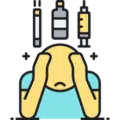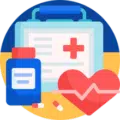Author(s)
Mallory Kuchis, PharmD
Michael P. Kane, PharmD, BCPS, BCACP
Reviewed By
Samuel Adeosun, Ph.D.
Daniel Riche, PharmD, BCPS
Emily Prohaska, PharmD, BCGP, BCACP
Mooijaart SP, Du Puy RS, Stott DJ, et al. Association between levothyroxine treatment and thyroid-related symptoms among adults aged 80 years and older with subclinical hypothyroidism [published online October 30, 2019]. JAMA. doi:10.1001/jama.2019.17274
The Problem
Patients with subclinical hypothyroidism often complain of symptoms commonly seen in patients with overt hypothyroidism: cold insensitivity, dry skin, fatigue, constipation, muscle cramps, poor memory, slowed thinking, and depression. Indeed, up to a quarter of people with normal TSH levels report up to two of these symptoms, pointing to the non-specific nature of these symptoms.1 How then should a clinician decide which patients might benefit from thyroid replacement therapy?
What’s Known
Subclinical hypothyroidism is a laboratory-defined phenomenon whereby a patient has an elevated thyroid stimulating hormone (TSH) level in the presence of a normal free thyroxine (FT4) level. An estimated 13 million people in the United States have subclinical hypothyroidism,2 with the highest prevalence found in women, older adults, and Caucasians.3 Subclinical hypothyroidism does progress to overt hypothyroidism in 2-5% of patient per year.4 The risk of progression is significantly greater in individuals with antibodies to thyroid peroxidase (TPO) and in those with higher baseline TSH levels.5,6
Multiple clinical practice guidelines for the treatment of subclinical hypothyroidism exist; however, recommendations are not consistent. Furthermore, these recommendations are largely based on consensus opinion and there are scant data regarding the benefits and risks of treating subclinical hypothyroidism in older adults.7-9 Subclinical hypothyroidism is often treated with thyroid hormone therapy,10 and levothyroxine is the most commonly prescribed medication in the United States with over 100 million prescriptions dispensed in 2017.11 Because serum thyrotropin levels rise as euthyroid individuals age,12,13 some have called for the adoption of a higher upper limit for the normal range for TSH in older adults.14
There is biological variation in TSH levels throughout the day with circadian changes in healthy individuals. Peak levels occur in the early morning and a nadir in the afternoon.15 Levels may also rise in response to physiologic stress and disease16 and over half of the patients with elevated TSH levels between 4-10 mIU/L will have normal TSH levels within five years without intervention.17 Guidelines recommend that an abnormal TSH level should be followed by a repeat blood test to confirm the diagnosis and treatment is generally recommended for persons 70 years of age or younger with TSH levels of > 10 mIU per liter.7-9 However, it should be noted that long-term benefits to this approach have not been demonstrated.
Little is known regarding treatment of subclinical hypothyroidism in older adults. Arguably, older adults are the most vulnerable to medication-related adverse effects and levothyroxine is a medication with a narrow therapeutic index. It is unclear whether levothyroxine treatment is beneficial in adults 80 years of age and older with subclinical hypothyroidism. Levothyroxine therapy is associated with iatrogenic thyrotoxicosis, leading to atrial fibrillation, cardiovascular (CV) events, and osteoporosis.18,19
What’s New
In a recent paper, investigators report the results of two randomized, double-blind, placebo-controlled, parallel-group trials assessing the use of levothyroxine to treat subclinical hypothyroidism in community-dwelling adults aged 80 years and older.20 This prospectively planned analysis combined data from the Institute of Evidence-Based Medicine in Old Age (IEMO) Trial and the Thyroid Hormone Replacement for Untreated Older Adults with Subclinical Hypothyroidism Trial (TRUST).21,22 The co-primary outcomes were changes in tiredness scores (7 items) and hypothyroid symptom scores (4 items) from baseline to 1 year using the Thyroid-Related Quality of Life Patient-Reported Outcome (ThyPRO) questionnaire. Higher scores indicate more symptoms and a minimal clinically important difference in score is 9 points. Fatal and nonfatal cardiovascular (CV) events were originally included as a prespecified primary outcome but required a protocol amendment when it became apparent there was an inadequate number of subjects to detect a meaningful difference between groups. CV events became a prespecified secondary outcome.
Patients aged 80 years and older with subclinical hypothyroidism (thyrotropin levels between 4.6 and 19.9 mIU/L and normal FT4 levels) confirmed on at least 2 separate occasions between 3 months and 3 years apart were eligible for trial inclusion. Patients were excluded if they were on levothyroxine, antithyroid medication, amiodarone, or lithium, had recent thyroid surgery or radioactive iodine therapy, New York Heart Association Class IV heart failure, a clinical diagnosis of dementia, a recent hospitalization for a major illness, a recent acute coronary syndrome, acute myocarditis, pericarditis, or a terminal illness.
Two hundred and fifty-one participants aged 80 years and older were randomized to receive levothyroxine or placebo. The population largely consisted of Caucasian (99%) males (53%) and the average age was 85 years. Mean baseline thyrotropin levels in the treatment (6.4 mIU/L) and placebo (6.3 mIU/L) groups were similar. There was a higher percentage of participants with ischemic heart disease in the placebo group (27.3% vs. 20.5%), but all other baseline characteristics were well matched. Patients in the levothyroxine group were initiated on a dose of 25 or 50 µg (depending on weight and CV status) and doses were adjusted in 25 µg increments. Thyrotropin levels were monitored at 6 to 8 weeks after initiation and dose adjustments, and at the 12-month and 24-month follow up visits. An identical titration schedule was used for the placebo group to maintain blinding.
Mean thyrotropin levels at 1 year were 3.69 mIU/L in the levothyroxine group and 5.49 mIU/L in the placebo group (estimated mean between-group difference, -1.9 mIU/L [95% CI, -2.49 to -1.45]; p<0.001). However, no association was found with the ThyPRO scores for hypothyroid symptoms or tiredness when comparing levothryroxine treatment to placebo (adjusted between-group difference, 1.27 [95% CI, -2.69 to 5.23]; p=0.53 and -0.10 [95% CI, -4.51 to 4.31]; p=0.96, respectively). Oddly, a significant increase was observed in body mass index (p = 0.01) and waist circumference (p = 0.04) in the group treated with levothyroxine. No significant association was noted between levothyroxine and the other secondary and end-of-study outcomes or the risk of adverse effects.
Our Critical Appraisal
This study aimed to answer a question that has not been adequately addressed. The two trials included in this analysis were well-matched, randomized, and double-blinded. Both trials assessed similar outcomes to those assessed in younger patient populations. Importantly, these trials provided insight into patients’ quality of life, which have not been previously reported for this age group.
The results are consistent with recommendations by US and European guidelines advising against the treatment of subclinical hypothyroidism in patients whose thyrotropin levels are <10 mIU/L without symptoms.7,8 However, existing guidelines do recommend treatment in patients with thyrotropin levels >10 mIU/L regardless of age (US) or if they are >70 years old (European).7,8 The results of this study, however, provide justification for withholding levothyroxine treatment in patients 80 years of age and older, and indicate that a change in the thyrotropin reference range may be warranted for this patient population.
Although this study provided some clarity into a controversial clinical question, it is not without limitations. It should be noted that the study did not include an analysis of patients with severely elevated thyrotropin levels or a high symptom burden. Similarly, the study was not powered to assess CV events as a primary outcome. In addition, the baseline characteristics did not include an assessment of antithyroid antibody levels, which could identify patients more likely to progress to overt hypothyroidism. The sample population was almost exclusively Caucasian, which may limit the generalizability of the results to other populations. Lastly, there was a large percentage of patients whose laboratory data were unavailable at the 1-year follow up (18% in the placebo group and 20% in the levothyroxine group), which may have contributed to a type 2 error regarding the statistical analysis of the prespecified outcomes.
The Bottom Line
Levothyroxine therapy was not associated with a significant improvement in hypothyroid symptoms, fatigue, or quality-of-life in patients age 80 years or older with subclinical hypothyroidism. These findings argue against the routine use of levothyroxine for the treatment of subclinical hypothyroidism, particularly in the oldest old.
The Key Points
- Treatment of subclinical hypothyroidism in adults age > 80 years did not lead to improvements in hypothyroid-like symptoms or quality of life.
- Patients with subclinical hypothyroidism and very elevated TSH concentrations > 10 mIU/L or positive antithyroid antibodies may benefit from treatment — this study did not address these populations.
- It is unknown if deprescribing levothyroxine in older adults with subclinical hypothyroidism would be beneficial … or harmful.
FINAL NOTE: This program will be available for recertification credit through the American Pharmacists Association (APhA) Ambulatory Care Review and Recertification Program. To learn more, visit https://www.pharmacist.com/ambulatory-care-review-and-recertification-activities.
1. Canaris GJ, Manowitz NR, Mayor G, Ridgway EC. The Colorado thyroid disease prevalence study. Arch Intern Med 2000;160:526-34.
2. Hollowell JG, Staehling NW, Flanders WD, et al. Serum TSH, T4, and thyroid antibodies in the United States population (1988 to 1994): National Health and Nutrition Examination Survey (NHANES III). J Clin Endocrinol Metab. 2002;87(2):489-499.
3. Cooper DS, Biondi B. Subclinical thyroid disease. Lancet. 2012;379(9821):1142-1154.
4. Vanderpump MPJ, Tunbridge WMG, French JM, et al. The incidence of thyroid disorders in the community: a twenty-year follow-up of the Whickham Survey. Clin Endocrinol (Oxf) 1995;43:55-68.
5. Huber G, Staub JJ, Meier C, et al. Prospective study of the spontaneous course of subclinical hypothyroidism: prognostic value of thyrotropin, thyroid reserve, and thyroid antibodies. J Clin Endocrinol Metab 2002;87:3221-6.
6. Díez JJ, Iglesias P. Spontaneous subclinical hypothyroidism in patients older than 55 years: an analysis of natural course and risk factors for the development of overt thyroid failure. J Clin Endocrinol Metab 2004;89:4890-7.
7. Garber JR, Cobin RH, Gharib H, et al; American Association of Clinical Endocrinologists and American Thyroid Association Taskforce on Hypothyroidism in Adults. Clinical practice guidelines for hypothyroidism in adults: cosponsored by the American Association of Clinical Endocrinologists and the American Thyroid Association. Thyroid. 2012;22(12):1200-1235.
8. Pearce SH, Brabant G, Duntas LH, et al. 2013 European Thyroid Association guideline: management of subclinical hypothyroidism. Eur Thyroid J. 2013;2(4):215-228.
9. Bekkering GE, Agoritsas T, Lytvyn L, et al. Thyroid hormones treatment for subclinical hypothyroidism: a clinical practice guideline. BMJ 2019;365:l2006 doi: 10.1136/bmj.l2006
10. Rodriguez-Gutierrez R, Maraka S, Ospina NS, Montori VM, Brito JP. Levothyroxine overuse: time for an about face? Lancet Diabetes Endocrinol. 2017;5(4):246-248.
11. Medicine use and spending in the US: a review of 2017 and outlook to 2022. IQVIA Institute For Human Data Science website. https://www.iqvia.com/insights/the-iqvia-institute/reports/medicineuse-and-spending-in-the-us-review-of-2017-outlook-to-2022. Published April 2018. Accessed Feb 2, 2020.
12. Tabatabaie V, Surks MI. The aging thyroid. Curr Opin Endocrinol Diabetes Obes 2013;20: 455-9.
13. Hennessey JV, Espaillat R. Diagnosis and management of subclinical hypothyroidism in elderly adults: a review of the literature. J Am Geriatr Soc. 2015;63(8):1663-1673.
14. Cappola AR. The Thyrotropin Reference Range Should Be Changed in Older Patients. JAMA. 2019 Oct 30. doi: 10.1001/jama.2019.14728. [Epub ahead of print]
15. Andersen S, Bruun NH, Pedersen KM, Laurberg P. Biologic variation is important for interpretation of thyroid function tests. Thyroid. 2003;13(11):1069-1078.
16. Roelfsema F, Veldhuis JD. Thyrotropin secretion patterns in health and disease. Endocr Rev. 2013;34(5):619-657.
17. Meyerovitch J, Rotman-Pikielny P, Sherf M, Battat E, Levy Y, Surks MI. Serum thyrotropin measurements in the community: five-year follow-up in a large network of primary care physicians. Arch Intern Med 2007;167:1533-8.
18. Baumgartner C, da Costa BR, Collet TH, et al; Thyroid Studies Collaboration. Thyroid function within the normal range, subclinical hypothyroidism, and the risk of atrial fibrillation. Circulation. 2017;136(22):2100-2116.
19. Flynn RW, Bonellie SR, Jung RT, MacDonald TM, Morris AD, Leese GP. Serum thyroid stimulating hormone concentration and morbidity from cardiovascular disease and fractures in patients on long-term thyroxine therapy. J Clin Endocrinol Metab. 2010;95(1):186-193.
20. Mooijaart SP, Du Puy RS, Stott DJ, et al. Association between levothyroxine treatment andthyroid-related symptoms among adults aged 80 years and older with subclinical hypothyroidism [published online October 30, 2019]. JAMA. doi:10.1001/jama.2019.17274
21. Stott DJ, Rodondi N, Kearney PM, et al; TRUST Study Group. Thyroid hormone therapy for older adults with subclinical hypothyroidism. N Engl J Med. 2017;376(26):2534-2544.
22. Du Puy RS, Postmus I, Stott DJ, et al. Study Protocol: A Randomised Controlled Trial on the Clinical Effects of Levothyroxine Treatment for Subclinical Hypothyroidism in People Aged 80 years and over. BMC Endocr Disord. 2018;18(1):67.





 iForumRx.org is a web-based community of practice designed to inform ambulatory care pharmacy specialists, pharmacy residents, and student pharmacists about high-quality, practice-changing evidence.
iForumRx.org is a web-based community of practice designed to inform ambulatory care pharmacy specialists, pharmacy residents, and student pharmacists about high-quality, practice-changing evidence.